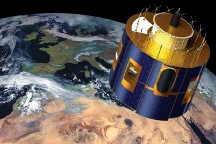Wednesday 27 February, 2013, 08:20 - Amateur Radio, Spectrum Management, Satellites
Posted by Administrator
Over in Brussels, the European Commission, through the direction given to it by the Radio Spectrum Policy Programme (RSPP), is trying to identify 1200 MHz of spectrum that can be made available for 'wireless broadband' services. At present there is 1025 MHz of spectrum available for such services including:Posted by Administrator
| Band | Allocation | Total Spectrum |
|---|---|---|
| Digital Dividend | 791 821 // 832 862 MHz | 60 MHz |
| 900 MHz | 880 915 // 925 960 MHz | 70 MHz |
| 1800 MHz | 1710 1785 // 1805 1880 MHz | 150 MHz |
| 2.1 GHz (FDD) | 1920 1980 // 2110 2170 MHz | 120 MHz |
| 2.1 GHz (TDD) | 1900 1920 MHz 2010 2025 MHz |
35 MHz |
| 2.6 GHz (FDD) | 2500 2570 // 2620 2690 MHz | 140 MHz |
| 2.6 GHz (TDD) | 2570 2620 MHz | 50 MHz |
| 3.6 GHz | 3400 3800 MHz | 400 MHz |
| Total | 1025 MHz | |
Finding another 175 MHz to make the goal of 1200 MHz is therefore surely not such a big ask. However, there are issues with the spectrum that is currently available. The 3400 3800 MHz band accounts for 400 MHz or a good third of it and despite already being allocated to broadband wireless in Europe, it has not been very popular. The slow take-up is partly due to a lack of mass market products for the band and the poorer propagation at these higher frequencies, but is also due to the need to protect certain C-Band satellite downlinks which remain in the band. This also forms the 9cm amateur band. It therefore seems sensible that if new spectrum is to be found, it ought to be below 3 GHz in order that it will prove popular enough to actually be put into use.
 To try and identify 'underused' spectrum, the European Commission is conducting a spectrum inventory whose purpose is to firstly examine the availability and use of spectrum and then to consider the future needs to try and match supply with demand. The first part of this inventory, a study which examined the extent to which each spectrum band is used was published in late 2012. The initial findings of the consultants who undertook the study were that the bands with the lowest current usage and thus which might be candidates for re-allocation were:
To try and identify 'underused' spectrum, the European Commission is conducting a spectrum inventory whose purpose is to firstly examine the availability and use of spectrum and then to consider the future needs to try and match supply with demand. The first part of this inventory, a study which examined the extent to which each spectrum band is used was published in late 2012. The initial findings of the consultants who undertook the study were that the bands with the lowest current usage and thus which might be candidates for re-allocation were:- 1452 1492 MHz. This band is set aside for DAB radio services, however it has remained virtually unused. The ECC have now recommended the re-allocation of this band for mobile services after pressure from Ericsson and Qualcomm to do so. This is therefore a 'no brainer' or a 'done deal'.
- 1980 2010 // 2170 2200 MHz. This band is currently allocated for 3G mobile satellite services to complement terrestrial 3G services. One satellite (Eutelsat 10A) was launched with a payload that is active in this band, but it failed to deploy the dish correctly and as such the band remains largely (though not completely) unused. It would seem churlish to take this away though, when there is still scope for it to be commercialised for its intended purpose. Perhaps some form of sharing using a complimentary ground component could be envisaged.
- 3400 3800 MHz. This was identified as being underused 'Quelle surprise' as they say in Brussels!
- 3800 4200 MHz. This is also part of the C-Band satellite downlink frequency range but has also been used for fixed links in some countries. Fixed links can be carefully controlled so as to avoid interference to satellite ground stations: it is unclear how a more widespread roll-out of services in this band would be feasible. This also fails the 'below 3 GHz' test.
- 5030 5150 MHz. This band is allocated for aeronautical use and was intended to be used for a new microwave landing system (MLS) to replace existing landing systems and for aeronautical mobile satellite services (AMSS). Very few airports or airlines have adopted MLS (London Heathrow and British Airways being two of the few who have done so) and no AMSS services in the band have been launched. If 3.5 GHz is not popular though, it seems unlikely that 5 GHz will be any more welcome.
- 5725 5875 MHz. This is a band which is available on either a licence exempt or a lightly licensed basis in most European countries for use with WiFi (802.11a) and other low power services. Being well over 3 GHz it is unlikely to be popular. It also forms a large chunk of the 6cm amateur band.
One option on the table, though not identified through the inventory, is the frequency band 2300 2400 MHz. It was identified at the 2007 World Radio Conference as a candidate for IMT (the ITU code for wireless broadband). It is already in the 3GPP standards for LTE, where it is known as the mysterious 'Band 40'. The ECC has considered the use of this band for wireless broadband services and concluded that it is quite possible. Sweden and Australia have already handed all of the band over to wireless broadband use, and many other countries (especially in Asia) have licensed part of it. One of the big problems with this band in Europe is that it is heavily used by governmental (read 'defence') services who are already smarting from the loss of many other bands over the past years and are in no mood for another re-farming exercise to release this band. Oh, and it represents the vast portion (and the most useful bit) of the 13cm amateur band.
 Meanwhile, over in the USA, the FCC has also recently assessed the possibility of reallocating some the frequency band 1675 -1710 MHz for wireless broadband uses. This band is currently used for the downlink for meteorological satellite services, however few satellites venture above 1695 MHz (with the possible exception of a couple of NOAA satellites, the Chinese Feng Yun satellites and the polar orbiting METOP) and there is almost nothing above 1700 MHz, unless you count satellites yet to be launched (such as GOES-R).
Meanwhile, over in the USA, the FCC has also recently assessed the possibility of reallocating some the frequency band 1675 -1710 MHz for wireless broadband uses. This band is currently used for the downlink for meteorological satellite services, however few satellites venture above 1695 MHz (with the possible exception of a couple of NOAA satellites, the Chinese Feng Yun satellites and the polar orbiting METOP) and there is almost nothing above 1700 MHz, unless you count satellites yet to be launched (such as GOES-R).Given the location of this spectrum, directly adjacent to the existing 1800 MHz band, and given that the associated pairing is also largely unused it might easily be possible to, say, extend the 1800 MHz band by 2 x 10 to become 1700 1785 // 1795 1880 MHz. Keeping the spacing between the up and downlinks would simplify the adoption of the new spectrum (in the same way that GSM became E-GSM). The 10 MHz gap in the middle is rather small which can cause handset manufacturers problems, but there are ways this could be dealt with. The loser here (other than some yet-to-be-launched satellites who could surely locate their downlink in the remaining part of the band) are radiomicrophones who are allocated 1785 1800 MHz. A screaming case of 'use it or lose it' if they are to retain this allocation.
And whilst we're pairing up things, how's about extending the 2.1 GHz band? The lower part of the pair, 1900 1920 MHz, is already licensed, albeit for TDD services. The upper part of the pair, 2090 2110 MHz is another of those military bands that would prove difficult to squeeze. The bigger problem here is that it contains sensitive satellite uplinks that are easily interfered with. Nonetheless, there was a terrestrial wireless network licensed in the band in the UK (Zipcom), if never actually launched.
So far, we have identified the following extra spectrum:
| Band | Allocation | Total Spectrum |
|---|---|---|
| L-Band | 1452 1492 MHz | 40 MHz |
| Extended 1800 MHz | 1700 1710 // 1795 1805 MHz | 20 MHz |
| Extended 2.1 GHz | 1900 1920 // 2090 2110 MHz | 20 MHz (20 MHz was already available) |
| 2.1 GHz MSS sharing | 1980 2010 // 2170 2200 MHz | 60 MHz (shared with satellite) |
| 2.3 GHz | 2300 2400 MHz | 100 MHz |
| Total | 240 MHz | |
That makes 240 MHz of potential new sub-3 GHz spectrum without too much pain and done in a way that is largely compatible with existing mobile bands, though not with existing defence or satellite sensitivities. Given the recent auction prices for spectrum, 240 MHz across Europe is worth something in the region of 75 billion Euro. So what would it cost to release it?

- L-Band is free in every sense of the word. Except possibly in the UK where it is owned by Qualcomm but presumably as they have been lobbying for it to become available for mobile services, they would have no qualms about using it for such. Cost: peanuts.
- Extended 1800 MHz The main affected party here are some meteorological satellite downlink sites. These are few and far between and could be protected through the use of an exclusion zone. Cost: cashew nuts.
- Extended 2.1 GHz The number of military satellites using the band 2090 2110 MHz is difficult to ascertain (for obvious reasons). There is also a need to re-farm the band 1900 1920 MHz. Cost: macadamia nuts.
- 2.1 GHz MSS sharing In theory there is nothing to stop this taking place even with a satellite already launched. To be completely fair, it would only be reasonable to recompense the licensees (Solaris and Intelsat) for their investments. Cost: pistachio nuts.
- 2.3 GHz Those defence boys have big toys (and big guns) that would be costly to replace. That being said, only around 40 MHz of this band is necessary if the target is 175 MHz and not 240 MHz. Surely releasing 40 MHz cant be that difficult no matter how big your toys. The fact that the band is destined for TDD means that it doesnt even need to be the same 40 MHz in each country. Cost: pistachio nuts.
Alternatively, perhaps radio amateurs who stand to lose the 13cm, 9cm and 6cm bands might wish to launch a counter-bid? After all, theyre replete with nuts (in a good way) !
add comment
( 2021 views )
| permalink
| 



 ( 3 / 2463 )
( 3 / 2463 )




 ( 3 / 2463 )
( 3 / 2463 )

